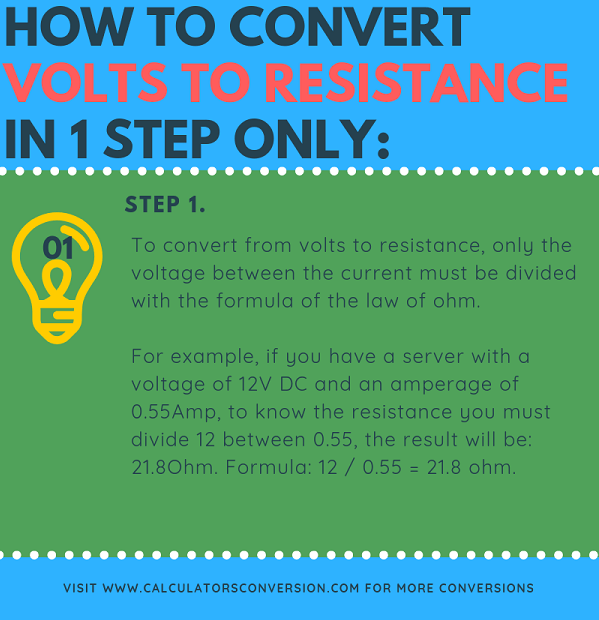With this calculator you can convert from volts to resistance using Ohm’s law.
To facilitate the compression, the formula of volts to resistance is explained , in addition we show how to convert from volts to resistance in 1 step , some examples of volts are made to resistance and finally a table of volts to resistance is presented .
Formula to convert volts to resistance (Ohm Law):
- R = Resistance in Ohm.
- I = Current in Amperes.
- V = Voltage.
How to convert volts to Resistance in 1 step only:
Step 1:
To convert from volts to resistance, only the voltage between the current must be divided with the formula of the law of ohm.
For example, if you have a server with a voltage of 12V DC and an amperage of 0.55Amp, to know the resistance you must divide 12 between 0.55, the result will be: 21.8Ohm. Formula: 12 / 0.55 = 21.8 ohm.
Examples for conversions from volts to resistance:
Example 1:
A DC motor for a remote control car has a voltage of 14.5V and an amperage of 0.25A, what would be the resistance of the DC motor of this car to remote control ?.
Answer: // To know the answer you must divide the voltage between the current in the following way: 14.5V / 0.25A = 58ohm.
Example 2:
An ebook or e-reader has a voltage of 8.2V and an amperage of 2.3Amp, which is the resistance of the electronic equipment of the ebook ?.
Answer: // To make the conversion, the voltage must be divided between the amperes, as indicated by the ohm law as follows: 8.2V / 2.3A = 3.5 ohm.
Example 3:
A portable computer has a voltage of 8.8 V and 3.3 Amp, what will be the resistance that will have the electronic equipment of the computer ?.
Answer: // It’s easy you just have to divide the voltage between the amperage as indicated in the formula: 3.5V / 2.4A, which will result in: 2.6 ohm.
Table of volts to resistance (Amperes: 10Amp):
| How many volts are: | Equivalence in resistance (Ohm) |
| 1.1 Volts | 0.1 Ohm |
| 1.7 Volts | 0.1 Ohm |
| 2.3 Volts | 0.2 Ohm |
| 2.9 Volts | 0.2 Ohm |
| 3.5 Volts | 0.3 Ohm |
| 4.1 Volts | 0.4 Ohm |
| 4.7 Volts | 0.4 Ohm |
| 5.3 Volts | 0.5 Ohm |
| 5.9 Volts | 0.5 Ohm |
| 10.6 Volts | 1.0 Ohm |
| 20.8 Volts | 2.0 Ohm |
| 30.2 Volts | 3.0 Ohm |
| 40.3 Volts | 4.0 Ohm |
| 50.7 Volts | 5.0 Ohm |
| 60.1 Volts | 6.0 Ohm |
| 70.5 Volts | 7.0 Ohm |
| 80.4 Volts | 8.0 Ohm |
| 90.6 Volts | 9.0 Ohm |
| 100.8 Volts | 10.0 Ohm |
| 110.9 Volts | 11.0 Ohm |
| 120.2 Volts | 12.0 Ohm |
| 130.6 Volts | 13.0 Ohm |
| 140.3 Volts | 14,0 Ohm |
| 150.8 Volts | 15,0 Ohm |
| 160.3 Volts | 16.0 Ohm |
| 170.1 Volts | 17.0 Ohm |
| 180.2 Volts | 18.0 Ohm |
| 190.0 Volts | 19.0 Ohm |
| 200.0 Volts | 20.0 Ohm |
Note: The changes of volts to resistance of the previous table were made taking into account a 10V amperage. For different variables you should use the calculator that appears at the beginning.
How to use the calculator:
You must enter the voltage and amperage, then just click on calculate, and as a result you will have resistance.
Rate conversion of volts to resistance (Ohm Law): [kkstarratings]

